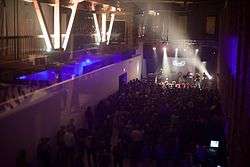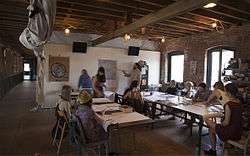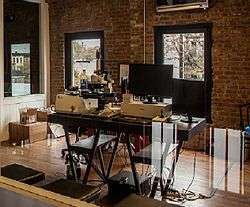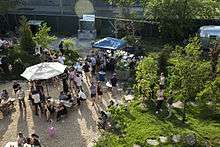Pioneer Works
|
The main hall at Pioneer Works, which has hosted major art exhibitions and large scale concerts and events | |
| Location | |
|---|---|
| Website |
www |
Pioneer Works is a non-profit foundation in Red Hook, New York City that fosters multidisciplinary creativity in the arts and sciences.
Mission
Pioneer Works helps produce creative work and social change. Collaboration between the arts and sciences is critical, and through exhibitions, performances, and publications, Pioneer Works exhibits an open vision of the world. In-depth participation is encouraged through residencies, classes, and lectures.[1]
In 2010, when artist Dustin Yellin purchased a colossal brick building for sale in Red Hook, Brooklyn, he was one step closer to bringing a long-standing idea to fruition.[2]
Since arriving in New York over a decade ago, Yellin had developed his career from scratch—but not in a vacuum. His progress was aided by continual exposure to the work of other talented artists and intellectuals. Though Yellin was continuing to establish his reputation, his artistic aim was to improve the culture as a whole, and he sought to provide a place where a variety of talented thinkers and artists could readily converge.[3] He purchased the building, and, in June 2012, Pioneer Works Center for Art and Innovation first opened its doors to the public.
Program initiatives




Exhibitions
The exhibition program revolves around an expansive, spectacular main space that acts as a major exhibit hall. There are also several smaller enclosed exhibition spaces for special projects.
Exhibits reflect Pioneer Works’ collaborative ethos, and the program is not driven by a single curatorial voice.[2]
Curators from a variety of backgrounds may work together on single exhibition.[4] Featured work displays a broad theoretical range, successfully uses a variety of media, indicates willingness to experiment with content and process, and challenges prevailing cultural models.
Pioneer Works attempts to show work without regard to an artist's reputation or standing in the art community. Exhibitions are not necessarily driven by financial gain. This helps those involved avoid the negative effects and pressure often associated with art made primarily for profit.[3]
Events
Special lectures, performances, and events serve as the backbone of the creative culture of Pioneer Works. Specialists from diverse backgrounds present work in a number of different ways, from traditional lectures to films to art installations and performances.
"The Fly Room Lecture Series" presented a series of lectures in and around a recreated 1920s laboratory within the larger building. Built by Imagine Science Films, the lectures focused on the history of genetics and the future of genomics as explored through film, master classes, lecture series, and an interactive exhibit.[5]
Musical performances are frequent and range from single performances to festivals. In 2012, over the weekend of October 11 and 12, Pioneer Works hosted more than a dozen performances to celebrate the five-year anniversary of independent record label Mexican Summer.[6]
Residencies
The Pioneer Works residency program aims to nurture creative practices while supporting emerging artists.[7] Housed within the facility, the program immerses artists in an environment that supports interdisciplinary discourse. The creative facilities available include a 3-D printer, a powerful microscope capable of printing the viewed image, a metalworking shop, a woodworking shop, and an analog photography studio.
Visual and performing artists—along with writers, musicians, designers, and scientists—are encouraged to share their ideas in a public presentation of their work produced over the course of the residency.[8]
Educational classes
Instructors explore both modern and distinctive traditional topics in an atypical style, encouraging students to creatively interpret the psychic and natural worlds using a variety of specialized tools and techniques. The goal is not to memorize information or mechanize process, but to synthesize the teachings of experts in various disciplines into a broad capacity to learn for oneself. There is no standardized curriculum per se, and although the fields of the arts and sciences are prevalent, courses range from circuitry design to specialized courses like lock-picking and advice on how to fake one’s own death.[9]
Science program
The Science Program aims to dismantle artificial institutional barriers between the arts and sciences, and in the process, to fuse technology, imagination, and experimental rigor. The program at Pioneer Works reunites the arts and sciences to help place particular problems into a broader cultural context. For example, how can we best understand the implications of modern genetics and rapidly evolving technology upon learning, the environment and social communication? A purely scientific model may not provide a complete response.

The Pioneer Works lab houses a powerful computer and photographic microscope, providing Ph.D. researchers, programmers, physicists, biologists and chemists with basic equipment for experimentation. Work ranges from algorithmic data mining to nanoscience and artificial intelligence. Physicist Matthew Putman Ph.D. is the current Science Director, and serves on the Board of Directors.
Those awarded residents are given unfettered access to the Pioneer Works facilities and are immersed in a large community of visual artists, authors, musicians, and scientists.[10]
Publications

Pioneer Works publishes Intercourse Magazine, an independent periodical committed to providing a genuine voice for modern art and culture, featuring a broad range of content and contributors. The first edition is currently available at local bookstores and at its website. The second issue will be published in early 2014.[11]
Other publishing efforts include books about individual artists. In 2013, to commemorate its exhibition of the same name, Pioneer Works released “Settlements,” a career study of the work of Ernesto Caivano at a dinner hosted at Pioneer Works.[12]
Pioneer Works also acts as a small press for artists, authors, and other innovators who receive funding for approved projects.
The site
Building
The renovation of its home building was the first major project for Pioneer Works. The intention was restore the building’s historic fundamental architecture while modernizing its internal systems to adapt to public use. The fields of historic restoration, environmental design, and modern architecture converged in efforts to create the space, giving form to an open, soaring gallery of light.[10]
Constructed in 1866 to house Pioneer Iron Works, the building was originally a factory for constructing large scale machines required by industry, including railroad tracks and machinery for sugar plantations. With a footprint of half an acre, it was one of the largest machine manufacturers in the United States. The building was burned to the ground by a devastating fire in 1881 and rebuilt shortly thereafter, operating until the end of WWII. The factory was a landmark that ultimately gave Pioneer Street its name.
Because the building is enormous, with an interior of roughly 27,000 square feet—including a ceiling height of 40' -- changes to the structure have been a formidable undertaking. Yellin enlisted the help of architect Sam Trimble to tackle the problem. One major concern was that natural light was completely absent. Over 100 windows were added, each almost 20 square feet.[2]
Under the direction of Gabriel Florenz, the interior walls were stripped, revealing vast stretches of original brick that was then re-pointed. Over eighty wooden joists were replaced. A wooden bridge crane (called a gantry) running throughout the entire space was restored to operation.
When the floor was being installed, restoration gave way to energy-efficient modern technology. The poured concrete floor was embedded with coils flushed with hot water heated by high-efficiency boilers. The use of radiant heat considerably reduces the environmental impact of acclimatizing the space.
The second floor is occupied by residents or those otherwise involved with the management of the Foundation. Overlooking the downstairs gallery, open studios with movable walls are designed to physically change dimensions depending upon current use. The studios have walls on only three sides, encouraging communication during the creative process.
Perpendicular to these studios, open walls framed by diagonal beams and windows enclose a larger space overlooking the main gallery.
On the mezzanine of the third floor are five more studio spaces (from 18'x 18’ to 34'x 18') and an enclosed science laboratory.[13]
The Garden at Pioneer Works
Initially, the half-acre garden was no more than junkyard filled with debris, boulders, and years of accumulated trash. This wasteland was stripped and laboriously cleaned until it was suitable for the installation of a garden. The main garden was initially designed by South Carolina landscape designer Taylor Drayton Nelson of Magnolia Gardens.[14] Over the next two growing seasons, the basic structure of the garden was formalized through patterns of everyday use, and eventually large plants were added.[10]

The garden itself has an open plan, with a central gravel picnic area surrounded by grassy, tree-covered hills. A tunnel through a hill gives novel access to the periphery, and irregular stone paths carry the visitor abroad amongst evergreens and cherries. A swinging, double entrance gate, built from scrap materials on site, provides a public entryway directly from the street. Sculpture from various artists complements nature’s efforts.
Just beyond the garden, a welding and fabrication studio is housed in shipping containers. Four containers have been converted to a two-story usable space. Downstairs, a bar and restaurant operate during events and performances. Second-floor access is provided by an outdoor spiral staircase. Upstairs, a music studio is in the design phase.
Hurricane Sandy
Months after much of the initial restoration was completed, five feet of water flooded the space, severely damaging the ground floor and halting development. The damage from Hurricane Sandy was extensive, and many of those living and working nearby suffered unexpected loss from the storm.[15]
At Pioneer Works, 3200 square feet of drywall was ruined. All ground-floor windows had to be refurbished. The wood shop, metal shop, and most equipment and machinery needed to be completely replaced. The bathrooms, only recently completed, had to be rebuilt. The facility was without electricity for two months.
After the flood, staff rallied to clean and rebuild the space. The garden was in disarray, with trees toppled and newly installed beds destroyed. Over a dozen trees were lost and entire sections of the garden were replanted with evergreen trees and new shrubs. The garden was partially redesigned. During the clean-up, Pioneer held a 200-person nighttime event using LED lighting.
References
- ↑ Sutton, Benjamin. “Inside the Artist's Construction Site: Dustin Yellin's Huge Art Center in Red Hook”. The L Magazine. Feb, 3, 2012.
- 1 2 3 Lipinski, Jed. “An Artist’s Big, Big Plans for Red Hook”. The New York Times. Jan. 13, 2012.
- 1 2 Fabricant, Annie. “Dustin Yellin-On Building 12-Ton Sculptures And A ‘Utopian Art Center’ in Brooklyn”. Huffington Post. February 1, 2012.
- ↑ Bolta, Edwin. “One On One With Dustin Yellin”. New Things. August 17, 2012.
- ↑ Meier, Allison. “Explore A Reconstruction Of A Landmark Genetics Laboratory, Swarmed With Flies”. Atlas Obscura. July 30, 2013.
- ↑ Pelly, Jenn. “Spiritualized, Ariel Pink, Linda Perhacs, More To Play Mexican Summer Fifth Anniversary Fest”. Pitchfork. September 16, 2013.
- ↑ Zimmer, Laurie. “Pioneer Works Open Studios.” Art Nerd New York. November 18, 2013.
- ↑ Wunch, Noah. “The Works: Inside Dustin Yellin’s Creative Utopia In Red Hook, Brooklyn”. Paper Magazine. December 2013.
- ↑ Galloway, Jordan. “Creative Classes Return To Red Hook”. Brooklyn Based. May 23, 2013.
- 1 2 3 Wallace, Craig. “Dustin Yellin”. Interview Magazine. 2012.
- ↑ Bower, Jessica. “Intercourse Magazine”. Magpile. August 26, 2013.
- ↑ Malle, Chloe.“Dustin Yellin and Tocca Host A Dinner In Red Hook”. Vogue. June 26, 2013.
- ↑ Goodyear,Sarah. “8 Reasons To Go To Red Hook”. newyork.com. April 19, 2013.
- ↑ Bender, Stephen."Birthplace of Southern Gardening-Charleston, South Carolina". Southern Living. April 1, 2009.
- ↑ Jovanovic, Rozalia. “Dustin Yellin Clears Red Hook Studio After Sandy, Contemplates Future”. Gallerist. November 1, 2012.
External links
Coordinates: 40°40′45″N 74°00′44″W / 40.679235°N 74.0122°W
